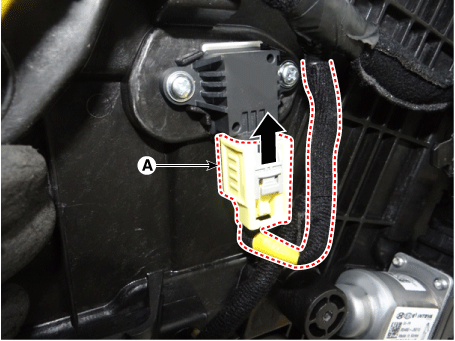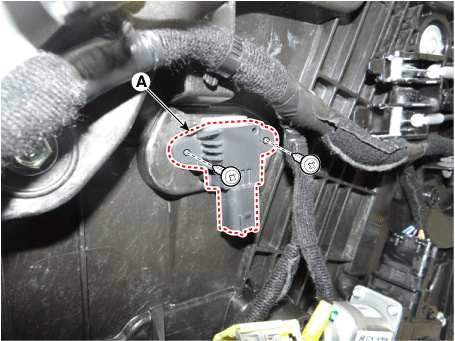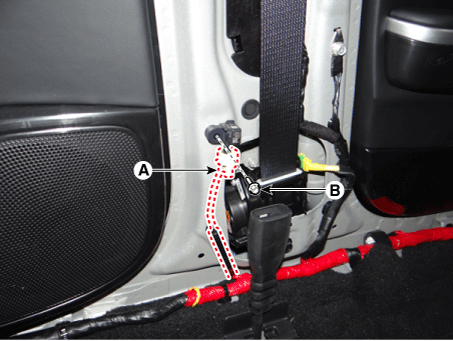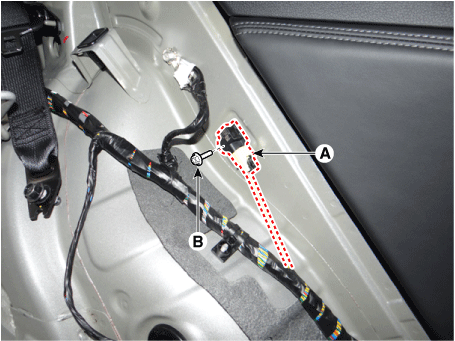Kia Stinger: SRSCM / Side Impact Sensor (SIS)
Description and operation
| Description |
| • |
Side Impact Sensor (SIS) system consists of two Pressure Side Impact Sensor (P-SIS) installed at each center of the front door module (LH and RH), two SIS installed at each center pillar nearby (LH and RH) and two rear SIS installed in the rear pillar (LH and RH). |
| • |
Pressure Side Impact Sensor is also called P-SIS because it detects pressure from collision at its mounting location. |
| • |
Side Impact Sensor is also called A-SIS because it detects acceleration. |
| • |
SRSCM decides deployment of the airbag and the time of deployment through the collision signal of the SIS when the collision occurred. |
Components and components location
| Components |
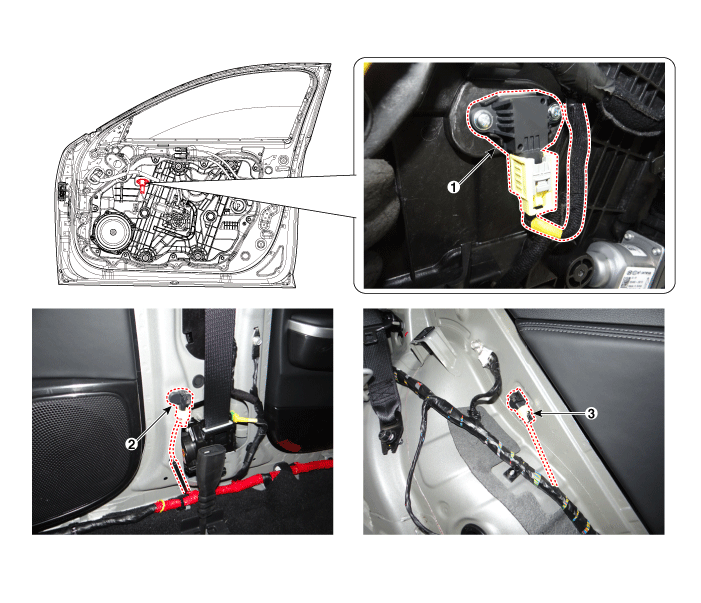
| 1. Front Pressure Side Impact
Sensor (P-SIS) 2. Front Gravity Side Impact Sensor (G-SIS) |
3. Rear side Impact Sensor (R-SIS)
|
Repair procedures
| Removal |
Front Pressure Side Impact Sensor (P-SIS)
| 1. |
Disconnect the negative battery terminal, and wait for at least thirty seconds before beginning to work. |
| 2. |
Remove the front door trim. (Refer to Body (Interior and Exterior) - "Front Door Trim") |
| 3. |
Remove the pressure side impact sensor (A).
|
| 4. |
Loosen the side pressure sensor mounting screw, and remove the sensor (A).
|
Front Gravity Side Impact Sensor (G-SIS)
| 1. |
Disconnect the negative battery terminal, and wait for at least thirty seconds before beginning to work. |
| 2. |
Remove the door scuff trim. (Refer to Body (Interior and Exterior) - "Door Scuff Trim") |
| 3. |
Remove the center pillar trim. (Refer to Body (Interior and Exterior) - "Center Pillar Trim") |
| 4. |
After disconnecting the side impact sensor connector (A) and loosening the bolt (B), remove the sensor.
|
Rear Side Impact Sensor (R-SIS)
| 1. |
Disconnect the negative battery terminal, and wait for at least thirty seconds before beginning to work. |
| 2. |
Remove the rear seat assembly. (Refer to Body (Interior and Exterior) - "Rear Seat Assembly") |
| 3. |
Remove the rear side impact sensor connect (A). |
| 4. |
Loosen the rear side impact sensor nut (B), and remove the sensor.
|
| Installation |
Front Pressure Side Impact Sensor (P-SIS)
| 1. |
Disconnect the negative battery terminal, and wait for at least thirty seconds before beginning to work. |
| 2. |
Install in the reverse order of removal. |
| 3. |
After installing the pressure side impact sensor, confirm proper system operation: • Switch "ON" the ignition. The SRS indicator light should turn on for about six seconds and then off.
|
Front Gravity Side Impact Sensor (G-SIS)
| 1. |
Disconnect the negative battery terminal, and wait for at least thirty seconds before beginning to work. |
| 2. |
Install in the reverse order of removal. |
| 3. |
After installing the side impact sensor, confirm proper system operation: • Switch "ON" the ignition. The SRS indicator light should turn on for about six seconds and then off. |
Rear Side Impact Sensor (R-SIS)
| 1. |
Disconnect the negative battery terminal, and wait for at least thirty seconds before beginning to work. |
| 2. |
Install in the reverse order of removal. |
| 3. |
After installing the side impact sensor, confirm proper system operation: • Switch "ON" the ignition. The SRS indicator light should turn on for about six seconds and then off. |
 Front Impact Sensor (FIS)
Front Impact Sensor (FIS)
Description and operation
Description
•
The front impact sensor (FIS) is installed in the Front End Module (FEM).
•
FIS is a remote sensor ...
 Seat Belt Buckle Switch (BS)
Seat Belt Buckle Switch (BS)
Description and operation
Description
The SRSCM shall monitor the status of the driver and front passenger seat belt
buckle. The SRSCM provides one pin each for the driver and front pa ...
Other information:
Kia Stinger CK 2018-2025 Service Manual: E-CVVT motor
Components and components location Components Appearance of E-CVVT is similar to that of hydraulic CVVT. Connector that drives DC motor and protection cover that protects the motor are mounted on the upper part. DC motor that drives the CVVT is mounted inside and covering part is s ...
Kia Stinger CK 2018-2025 Owners Manual: Floor mat anchor (s)
When using a floor mat on the front floor carpet, make sure it attaches to the floor mat anchor(s) in your vehicle. This keeps the floor mat from sliding forward. WARNING - After market floor mat Do not install aftermarket floor mats that are not capable of being securely attached to the veh ...

